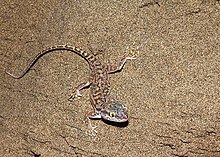| Crossobamon eversmanni | |
|---|---|

| |
| Conservation status | |
 Least Concern (IUCN 3.1) | |
| Scientific classification | |
| Domain: | Eukaryota |
| Kingdom: | Animalia |
| Phylum: | Chordata |
| Class: | Reptilia |
| Order: | Squamata |
| Family: | Gekkonidae |
| Genus: | Crossobamon |
| Species: | C. eversmanni |
| Binomial name | |
| Crossobamon eversmanni (Wiegmann, 1834) | |
| Synonyms | |
| |
Crossobamon eversmanni, also known commonly as the comb-toed gecko, is a species of Asian gecko, a lizard in the family Gekkonidae.
Etymology
The specific name, eversmanni, is in honor of Russian-German entomologist Alexander Eduard Friedrich Eversmann.
Geographic range
C. eversmanni is found in Iran, Pakistan, and several other countries of Central Asia.
Habitat
The preferred natural habitat of C. eversmanni is sandy areas of desert, grassland, and shrubland, at altitudes of 550–1,463 m (1,804–4,800 ft).
Behavior
C. eversmanni is terrestrial, nocturnal, and lives in burrows.
Reproduction
C. eversmanni is oviparous. A sexually mature female may lay 2–3 clutches per year, with 1–2 eggs in each clutch.
Subspecies
Two subspecies are recognized as being valid, including the nominotypical subspecies.
- Crossobamon eversmanni eversmanni (Wiegmann, 1834)
- Crossobamon eversmanni lumsdenii (Boulenger, 1887)
Nota bene: A trinomial authority in parentheses indicates that the subspecies was originally described in a genus other than Crossobamon.
References
- ^ Papenfuss T, Shafiei Bafti S, Orlov NL, Nazarov R, Sattorov T (2021). "Crossobamon eversmanni ". The IUCN Red List of Threatened Species 2021: https://dx.doi.org/10.2305/IUCN.UK.2021-3.RLTS.T164755A1073135.en. Accessed on 08 February 2023.
- ^ Crossobamon eversmanni at the Reptarium.cz Reptile Database
- Beolens, Bo; Watkins, Michael; Grayson, Michael (2011). The Eponym Dictionary of Reptiles. Baltimore: Johns Hopkins University Press. xiii + 296 pp. ISBN 978-1-4214-0135-5. (Crossobamon eversmanni, p. 86).
Further reading
- Boulenger GA (1887). Catalogue of the Lizards in the British Museum (Natural History). Second Edition. Volume III. Lacertidæ, Gerrhosauridæ, Scincidæ, Anelytropidæ, Dibamidæ, Chamæleontidæ. London: Trustees of the British Museum (Natural History). (Taylor and Francis, printers). xii + 575 pp. + Plates I-XL. (Stenodactylus lumsdenii, new species, p. 479).
- Wiegmann AFA (1834). Herpetologia Mexicana, seu descriptio amphibiorum Novae Hispaniae, quae itineribus comitis de Sack, Ferdinandi Deppe et Chr. Guil. Schiede in Museum Zoologicum Berolinense pervenerunt, Pars prima, saurorum species amplectens. Adiecto systematis saurorum prodromo, additisque multis in hunc amphibiorum ordinem observationibus. Berlin: C.G. Lüderitz. vi + 54 pp. + Plates I-X. (Gymnodactylus eversmanni, new species, p. 19). (in Latin).
| Taxon identifiers | |
|---|---|
| Crossobamon eversmanni | |
This article about a gecko is a stub. You can help Misplaced Pages by expanding it. |